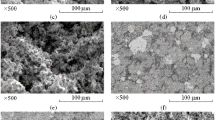It is established that structured phase formation in the diamond–(Fe–Cu–Ni–Sn) composite proceeds in the sequence different from that determined by the known phase diagrams. Depending on the processes of hot recompaction, the diamond−matrix transition zone attains a hierarchical structure and fully decarburizes through the formation of 5–40 nm Fe3C layers, thus enhancing the mechanical properties of the composite.






Similar content being viewed by others
Notes
The composition is in wt.% here and further in the text.
References
N. V. Novikov (ed.), N. A. Bondarenko, A. N. Zhukovskii, and V. A. Mechnik, Basis for Developing Diamond Composites for Rock Cutting Tools [in Russian], Inst. Sverkhtverd. Mater., NAN Ukrainy, Kiev (2008), p. 456.
N. V. Novikov, V. A. Mechnik, N. A. Bondarenko, et al., “Structure and properties of Superhard diamond composites,” Dop. NAN Ukrainy, No. 11, 88−90 (2003).
N. V. Novikov, N. A. Bondarenko, O. G. Kulik, et al., “Physical and mathematical modeling of sintering of multicomponent diamond composites. II. Physicochemical features of structure and properties,” Fiz. Mezomekh., 7, No. 3, 79–87 (2004).
M. O. Bondarenko and V. A. Mechnik, “Effect of hot recompaction parameters on the structure and properties of diamond−Fe–Cu–Ni–Sn composites for rock cutting tools,” Nauk. Prats. DonNTU. Ser. Girn. Geol., 181, Issue 14, 143−149 (2011).
G. G. Gnesin (ed.), Yu. V. Naidich, V. P. Umanskii, and I. A. Lavrinenko, Strength of Diamond–Metal Contact and Diamond Soldering [in Russian], Naukova Dumka, Kiev (1988), p. 136.
A. P. Savitskii, Liquid-Phase Sintering of Systems with Interacting Components [in Russian], Nauka, Novosibirsk (1991), p. 184.
V. A. Mechnik, “Energy aspects of structural improvement of superhard materials. Diamond− (Fe + Cu + Ni + Sn) system,” Probl. Mashinostr., 10, No. 3, 87–93 (2007).
V. A. Mechnik, “Structural features and properties of diamond–(51 % Fe–325 Cu–95 Ni–85 Sn) composites differing in sintering methods,” Nauk. Visn. Nats. Girn. Univ., No. 7, 10–14 (2007).
M. O. Bondarenko, V. A. Mechnik, O. O. Kurakevich, et al., “Mechanisms of mass transfer and structurization in the diamond-containing system in the presence of energy barriers,” Fiz. Khim. Tverd. Tela, 12, No. 2, 301−310 (2011).
N. A. Bondarenko and V. A. Mechnik, “On the nature of high diamond retention in diamond−Fe–Cu–Ni–Sn composites produced by a combined method,” in: Rock Cutting and Metalworking Tools−−Production Equipment and Technologies and Applications (Collected Scientific Papers) [in Russian], Issue 14, Inst. Sverkhtverd. Mater. NAN Ukrainy, Kiev (2011), pp. 327–334.
V. A. Mechnik, “Diamond−Fe–Cu–Ni–Sn composite materials with predicted stable characteristics,” Fiz. Khim. Mekh. Mater., No. 5, 34−42 (2012).
Metal Binders of M6-14 (MZh), M6-15 (M3), and M6-16 (MO3) Grades [in Russian], Enterprise Standard STP 90.502−65, introduced September 1 (1985).
M. O. Bondarenko, V. A. Mechnik, O. M. Zhukovskii, et al., Charge for Making Abrasive Material [in Ukrainian], Ukrainian Patent 64274, IPC B24D3/04, B22F3/12, E21B10/46, C22C29/14; Inst. Sverkhtverd. Mater. NAN Ukrainy; appl. February 24, 2003; Bulletin No. 12, publ. December 15 (2005), p. 5.
M. O. Bondarenko, A. F. Lisovskii, and V. A. Mechnik, Superhard Composite Material [in Ukrainian], Ukrainian Patent 63989, IPC B24D3/04, B24D3/06; Inst. Sverkhtverd. Mater. NAN Ukrainy; appl. April 4, 2011; Bulletin No. 20, publ. January 25 (2011), p. 4.
W. Kraus and G. Nolze, “Powder Cell—a program for the representation and manipulation of crystal structures and calculation of the resulting X-ray powder patterns,” J. Appl. Cryst., 29, 301−303 (1996).
Powder Diffraction File 1974, Search Manual Alphabetical Listing and Search Section of Frequently Encountered Phases. Inorganic, Philadelphia (1974).
R. P. Selig, “Fundamentals of pressing of metal powder,” in: W. E. Kingston (ed.), The Physics of Powder Metallurgy, Book Comp. Inc., McGraw-Hill (1951), pp. 344−371.
Author information
Authors and Affiliations
Corresponding author
Additional information
Translated from Poroshkovaya Metallurgiya, Vol. 52, No. 9–10 (493), pp. 115–127, 2013.
Rights and permissions
About this article
Cite this article
Mechnik, V.A. Production of Diamond−(Fe−Cu−Ni−Sn) Composites with High Wear Resistance. Powder Metall Met Ceram 52, 577–587 (2014). https://doi.org/10.1007/s11106-014-9563-9
Received:
Published:
Issue Date:
DOI: https://doi.org/10.1007/s11106-014-9563-9



